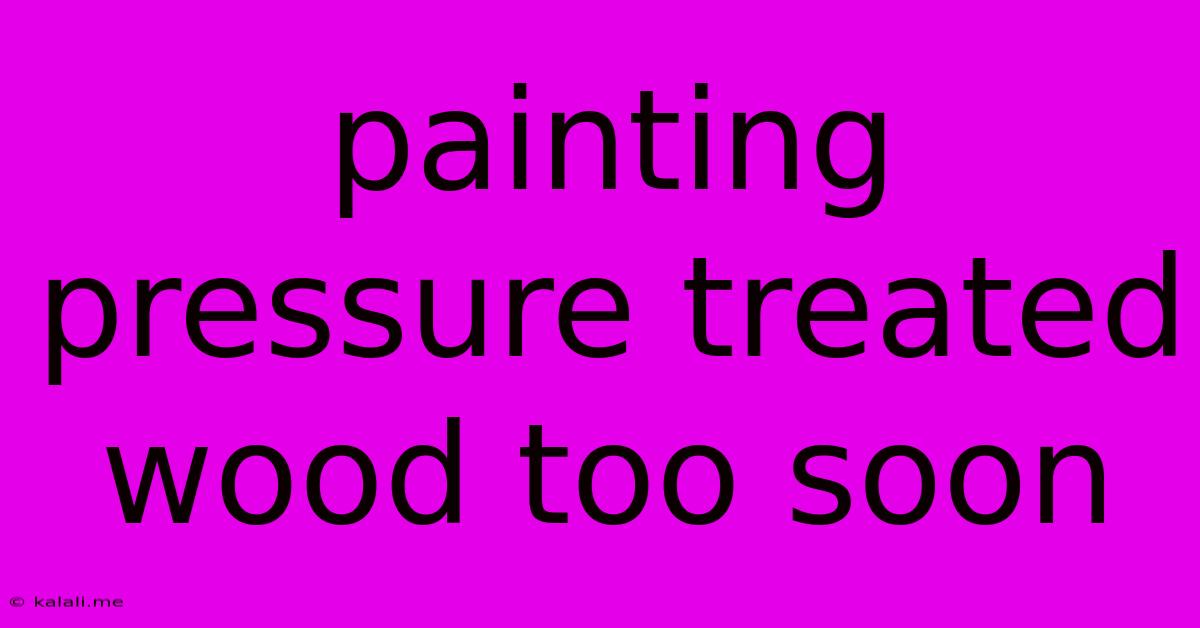Painting Pressure Treated Wood Too Soon
Kalali
Jun 02, 2025 · 3 min read

Table of Contents
Painting Pressure Treated Wood Too Soon: A Recipe for Disaster?
Meta Description: Learn the crucial reasons why painting pressure treated lumber prematurely leads to paint failure. Discover the ideal waiting period and best practices for a long-lasting, beautiful finish on your pressure-treated projects.
Pressure-treated wood is a popular choice for outdoor projects, offering durability and resistance to rot and insects. However, rushing into painting it can lead to significant problems down the line. This article delves into the reasons why you should wait before painting pressure-treated wood and provides guidance on achieving a successful, long-lasting paint job.
Why You Shouldn't Paint Pressure Treated Wood Immediately
The process of pressure treating wood involves injecting it with preservatives, typically copper-based compounds. These chemicals are crucial for protecting the wood from decay, but they also play a significant role in how paint adheres. Painting too soon prevents the wood from properly drying and curing, leading to several issues:
- Paint Peeling and Blistering: The moisture trapped within the wood will push against the newly applied paint, causing it to peel, blister, or crack. This significantly reduces the lifespan of your paint job and necessitates costly repainting.
- Poor Adhesion: The preservatives can interfere with the paint's ability to bond correctly to the wood surface. Premature painting results in weak adhesion, increasing the likelihood of chipping, flaking, and overall paint failure.
- Chemical Reactions: The chemicals in the pressure treatment can react with certain paint types, leading to discoloration, fading, or even damaging the paint itself. This can result in an uneven, unsightly finish.
- Compromised Wood Protection: While pressure treatment provides initial protection, the paint acts as an additional barrier against moisture and the elements. A poorly applied paint job due to premature painting defeats this purpose, leaving the wood vulnerable to damage.
How Long Should You Wait Before Painting?
The ideal waiting period before painting pressure-treated wood depends on several factors, including the type of wood, the climate, and the thickness of the lumber. However, a general guideline is to allow at least 3-6 months for the wood to dry thoroughly. In areas with high humidity or rainfall, you might need to wait even longer – potentially up to a year.
You can test if the wood is ready by checking for moisture. If the wood feels damp or shows signs of moisture buildup, it's not ready to be painted.
Preparing Pressure-Treated Wood for Painting
Once the wood has sufficiently dried, proper preparation is key to a successful paint job:
- Cleaning: Thoroughly clean the wood surface to remove dirt, debris, mildew, and any loose splinters. A pressure washer can be effective but use caution to avoid damaging the wood.
- Sanding: Lightly sand the surface to create a smoother finish and improve paint adhesion.
- Priming: Applying a high-quality primer specifically designed for pressure-treated wood is highly recommended. This will help seal the wood and create a better surface for the paint to adhere to.
- Painting: Apply several thin coats of exterior paint designed for wood, allowing each coat to dry completely before applying the next.
By following these guidelines and patiently waiting for the wood to cure, you can ensure a beautiful and long-lasting paint job on your pressure-treated projects. Remember, taking the time for proper preparation is far more cost-effective than dealing with premature paint failure.
Latest Posts
Latest Posts
-
Is 1 Hour 45 Minutes Layover Enough Lax
Jun 04, 2025
-
Why Is Charisma Bad In New Vegas
Jun 04, 2025
-
Do The Medians Of A Triangle Trisect
Jun 04, 2025
-
When I Was A Kid In Spanish
Jun 04, 2025
-
Add Water To Stove Top Cook Method Name
Jun 04, 2025
Related Post
Thank you for visiting our website which covers about Painting Pressure Treated Wood Too Soon . We hope the information provided has been useful to you. Feel free to contact us if you have any questions or need further assistance. See you next time and don't miss to bookmark.